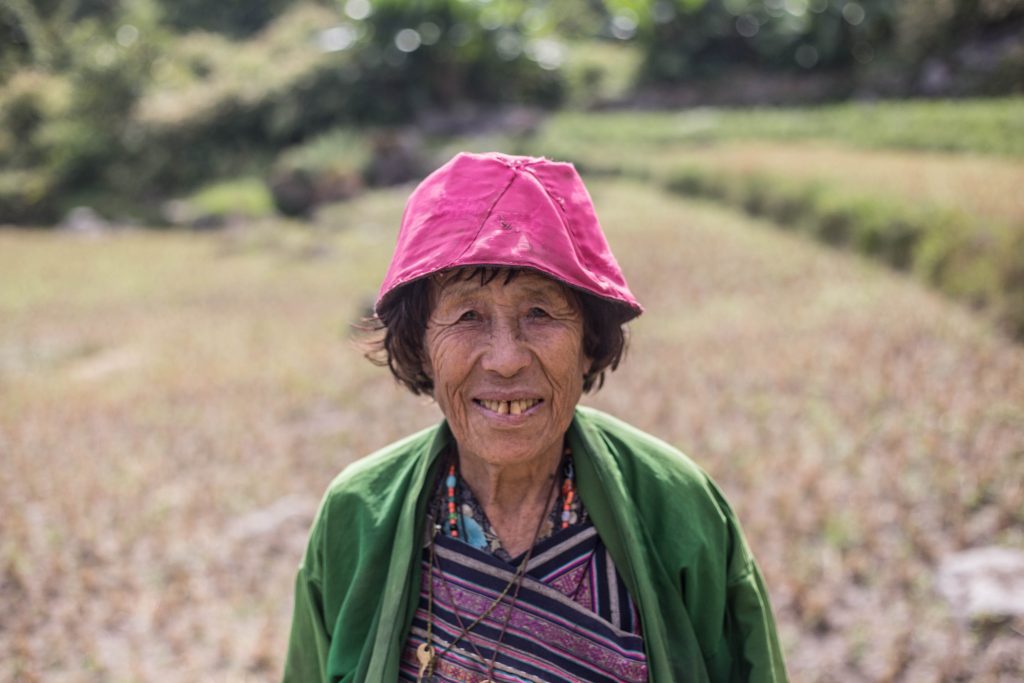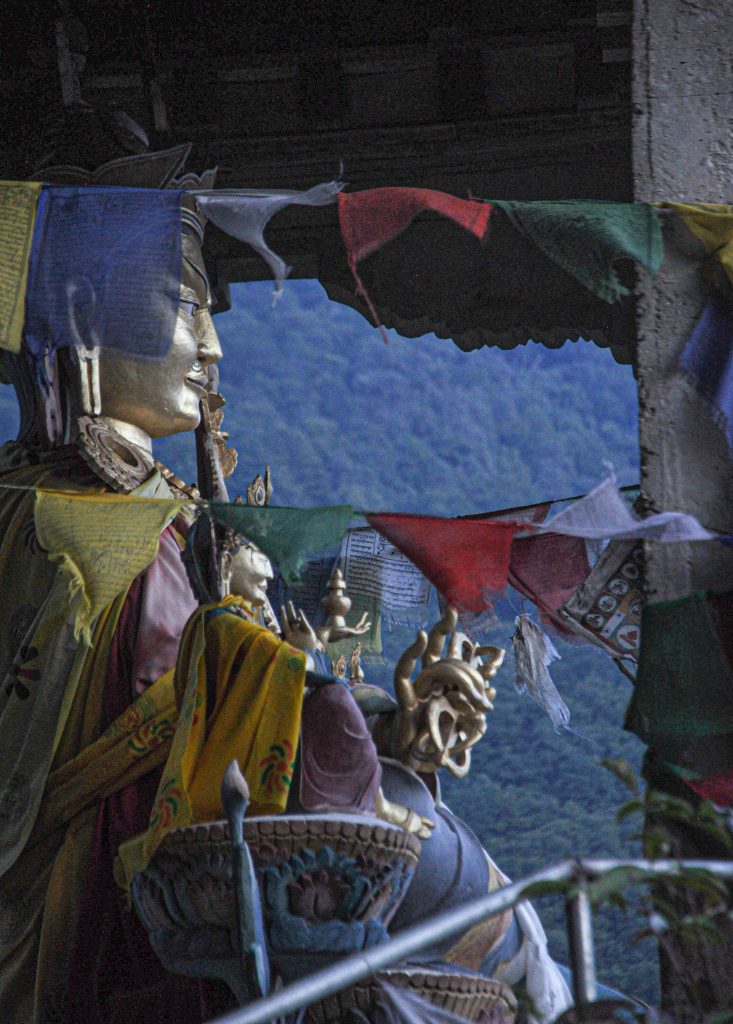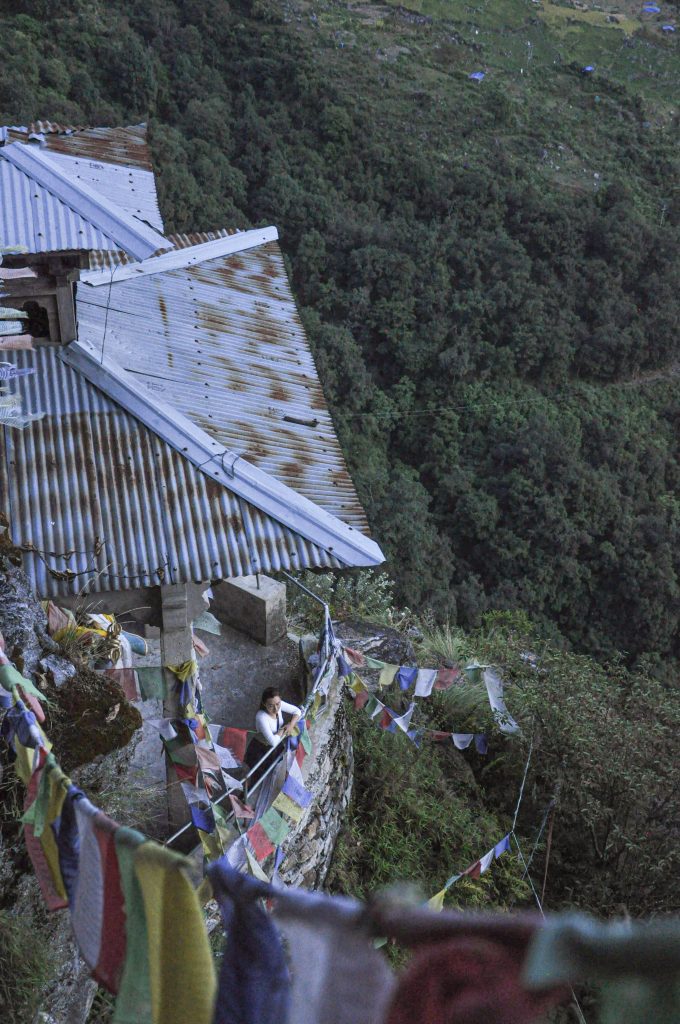
The Walk to Omba Ney
There are two ways to get to Omba. One: drive to the junction of the Toedtsho Primary school (1 hour from Toedtsho) and take the 3 hour walk towards Omba village and then climb straight up towards the ney (this is the easier walk but takes longer)
Two: you can hike to Omba village directly from Kheni village, which is just a few minutes below the gewog office. The walk is steep and brutal during midday sun but will take you an hour to reach Omba village if the ascent doesn’t slow you down.
We took the first route. The 3 hour route is a gradual ascent towards Omba village which takes you through small village houses, deep forests and a very high suspension bridge. After three hours we finally reached Omba village, which sits at the bottom of the cliff of the temple.

Omba Village
Omba is a quaint little village where people still walk for hours to reach the nearest motor road. Stop by Omba village’s only home stay for tea. You will enjoy this rest before you start your final ascent towards the sacred Omba site. The whole village of Omba consists of 15 households. In 2018 the villagers formed a group named Omba Takshell Association to promote tourism in the area. The group focuses on environment protection, tradition and culture conservation, socio economic development with women empowerment. So if you wish to help the village, do stop by their homestay and meet the locals.



Walk to Omba Ney
Along the final ascent you’ll come across many more of Guru Rinpoche’s imprints. As these holy rock impressions can be difficult to spot, you’ll find numbered signs that specifically describe each print. You’ll find one of an old serpent deity. It is said that Guru Rinpoche, while traveling here with his horse, was confronted by the deity. The serpent deity scared Guru Rinpoche’s horse and Guru Rinpoche then placed his palm right on the stone and turned the serpent deity into stone. After the tour along the way we finally arrived at a narrow steep trail taking us to the temple.

While beautifully constructed railings protect walkers on their hike to Taktshang, you can only resort to holding to the walls of the rock cliff as you make your final steps upwards to the temple. There are no railings here. And finally after a frightening tread up narrow staircases we reach the small temple overlooking the beautiful villages and mountains in this part of Trashiyangtse.

Omba was named after the sighting of the chhokey letter ‘OM’ on the site’s rock. This sacred place is considered to be one of the three important Buddhist sites identified by Guru Rinpoche. There is also a magnificent Guru statue just above the temple. Go there even if the steep ascent frightens you. Sitting near the statue as you look at the sun setting on a mountain range is a sight you’ll never forget.

Why Many Don’t Know about Omba Ney
While western Bhutan scrambles to find solutions with mass tourism, this part of the country is beautifully serene & tranquil. Places like Omba Ney and other sacred sites in the east are not disturbed as much although it is open for tourists. While I was overjoyed at the luxury of travelling in this part of Bhutan without being deterred by the effects that come with mass tourism, I knew that the communities here also deserve to reap the benefits of tourism – regulated tourism. .
There are very few homestays, or hotels here. Youth are leaving their parents’ farmlands to find work in the city. Artisans have to send their work all the way to Thimphu for sale through middlemen. So although we can be thankful that the east still has its pristine beauty, there is a need for tourism to be diverted here. How? That’s a whole other story. Meanwhile I shall reflect on my good fortune of being here with this beautiful view.

Walk Down from Omba
After spending some time at the temple and watching the sun set, we didn’t realize how quickly dusk arrived. We carefully meandered through the edge of the cliff relying on the dwindling evening light. As we arrived at the chhorten with the benches, we saw a silhouette in the dark – standing there as if waiting for us. It was a Tshampa (hermit) and he served us hot tea from his little hut on the cliff.
While I sat on the bench on the edge overlooking nothing but darkness, I realized that every sip of tea tasted more intense during our hikes, even the flavors of food (even if it’s a simple ema datsi) tasted more special than usual. Maybe it is the food…or maybe this is what my father always meant by “mindfulness”.
If you want more information about traveling to Omba, contact the Trashiyangtse Dzongkhag administration.
Read more blogs about Trashiyangtse only on yeegetaway.com